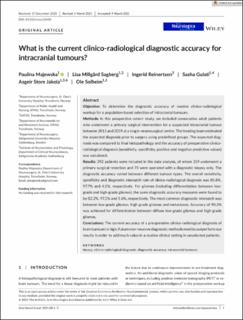| dc.description.abstract | Objective
To determine the diagnostic accuracy of routine clinico-radiological workup for a population-based selection of intracranial tumours.
Methods
In this prospective cohort study, we included consecutive adult patients who underwent a primary surgical intervention for a suspected intracranial tumour between 2015 and 2019 at a single-neurosurgical centre. The treating team estimated the expected diagnosis prior to surgery using predefined groups. The expected diagnosis was compared to final histopathology and the accuracy of preoperative clinico-radiological diagnosis (sensitivity, specificity, positive and negative predictive values) was calculated.
Results
392 patients were included in the data analysis, of whom 319 underwent a primary surgical resection and 73 were operated with a diagnostic biopsy only. The diagnostic accuracy varied between different tumour types. The overall sensitivity, specificity and diagnostic mismatch rate of clinico-radiological diagnosis was 85.8%, 97.7% and 4.0%, respectively. For gliomas (including differentiation between low-grade and high-grade gliomas), the same diagnostic accuracy measures were found to be 82.2%, 97.2% and 5.6%, respectively. The most common diagnostic mismatch was between low-grade gliomas, high-grade gliomas and metastases. Accuracy of 90.2% was achieved for differentiation between diffuse low-grade gliomas and high-grade gliomas.
Conclusions
The current accuracy of a preoperative clinico-radiological diagnosis of brain tumours is high. Future non-invasive diagnostic methods need to outperform our results in order to add much value in a routine clinical setting in unselected patients. | en_US |

